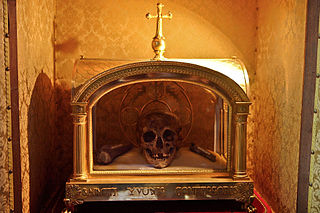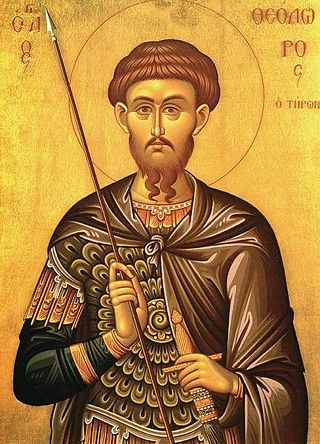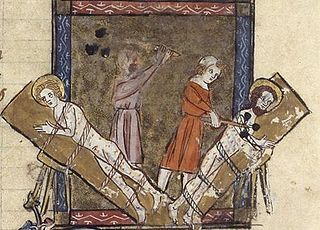
Canonization is the declaration of a deceased person as an officially recognized saint, specifically, the official act of a Christian communion declaring a person worthy of public veneration and entering their name in the canon catalogue of saints, or authorized list of that communion's recognized saints.

In religion, a relic is an object or article of religious significance from the past. It usually consists of the physical remains or personal effects of a saint or other person preserved for the purpose of veneration as a tangible memorial. Relics are an important aspect of some forms of Buddhism, Christianity, Islam, shamanism, and many other religions. Relic derives from the Latin reliquiae, meaning "remains", and a form of the Latin verb relinquere, to "leave behind, or abandon". A reliquary is a shrine that houses one or more religious relics.

Fermin was a legendary holy man and martyr, traditionally venerated as the co-patron saint of Navarre, Spain. His death may be associated with either the Decian persecution (250) or Diocletianic Persecution (303).

Vincent of Saragossa, the Protomartyr of Spain, was a deacon of the Church of Saragossa. He is the patron saint of Lisbon and Valencia. His feast day is 22 January in the Catholic Church and Anglican Communion and the Orthodox Church, with an additional commemoration on 11 November in the Orthodox Church. He was born at Huesca and martyred under the Emperor Diocletian around the year 304.

Saint Theodore, distinguished as Theodore of Amasea, Theodore the Recruit, and by other names, is a Christian saint and Great Martyr, particularly revered in the Eastern Orthodox Churches but also honored in Roman Catholicism and Oriental Orthodoxy. According to legend, he was a legionary in the Roman army who suffered martyrdom by immolation at Amasea in Galatian Pontus during the Great Persecution under Diocletian in the early 4th century. Venerated by the late 4th century, he became a prominent warrior saint during the Middle Ages, attracted a great deal of additional legends including accounts of battle against dragons, and was often confused with the similar Theodore Stratelates of Heraclea.

July 22 - Eastern Orthodox Church calendar - July 24

Saint Anastasia is a Christian saint and martyr who died at Sirmium in the Roman province of Pannonia Secunda. In the Eastern Orthodox Church, she is venerated as St. Anastasia the Pharmakolytria, i.e. "Deliverer from Potions". This epithet is also translated as "One who Cures (Wounds)" in Lampe's A Patristic Greek Lexicon.

Gervasius and Protasius are venerated as Christian martyrs, probably of the 2nd century. They are the patron saints of Milan and of haymakers and are invoked for the discovery of thieves. Their feast day in the Latin Rite of the Catholic Church is 19 June, the day marking the translation of their relics. In the Eastern Orthodox Church and in the Eastern Rites of the Catholic Church, their feast takes place on 14 October (O.S.)/24 October (N.S.), the traditional day of their death. In Christian iconography their emblems are the scourge, the club and the sword.

The Four Crowned Martyrs or Four Holy Crowned Ones were nine individuals who are venerated as martyrs and saints of Early Christianity. The nine saints are divided into two groups:
- Severus, Severian(us), Carpophorus (Carpoforus), Victorinus
- Claudius, Castorius, Symphorian (Simpronian), Nicostratus, and Simplicius

The Basilica of the National Shrine of the Little Flower also called Our Lady of Mount Carmel and St. Thérèse Church is a historic Roman Catholic church, located in San Antonio, Texas, in the United States. The church is distinguished as one of 84 in the United States bearing the papal designation of "minor basilica." Despite its religious importance it is not the cathedral of the local diocese; that distinction belongs to San Fernando Cathedral.

Saint Praxedes, called "a Roman maiden", was a saint and virgin who lived in the Roman Empire during the 2nd century. Along with her sister, Saint Pudentiana, she provided for the poor and gave care and comfort to persecuted Christians and martyrs. Her veneration began in the 4th century and many churches have been dedicated to her.

Saint Leocadia is a Spanish saint. She is thought to have suffered martyrdom and died on December 9, ca. 304, in the Diocletianic Persecution.

Saint Cucuphas is a martyr of Spain. His feast day is 25 July but in some areas it is celebrated on 27 July to avoid conflict with the important feast day of Santiago, the patron saint of Spain. His name is said to be of Phoenician origin with the meaning of "he who jokes, he who likes to joke."
Saints Speusippus, Eleusippus, and Melapsippus (Meleusippus) are venerated as Christian martyrs. Their legend states that Speusippus, Eleusippus, and Melapsippus were Cappadocian triplets who were martyred under Marcus Aurelius.

Saints Victor and Corona are two Christian martyrs. Victor was a Roman soldier who was tortured and killed; Corona was killed for comforting him. Corona is invoked as a patron of causes involving money; she was not historically associated with pandemics or disease, but has been invoked against the coronavirus pandemic.
Saint Latuinus is venerated as a saint by the Roman Catholic Church. He is considered to have been the first bishop of Sées, during the 5th century, from 400 to 440 AD. According to the Catholic Encyclopedia, "Louis Duchesne believed that for the period anterior to 900 no reliance can be placed on the episcopal catalogue of Séez, which we know by certain compilations of the sixth century."

Saint Antoninus of Pamiers was an early Christian missionary and martyr, called the "Apostle of the Rouergue". His life is dated to the first, second, fourth, and fifth century by various sources since he is often confused with various other venerated Antonini. Today he is revered as the patron saint of Pamiers, Palencia, and Medina del Campo. His historicity and exact identity are in doubt.

Saint Eleutherius of Tournai is venerated as a saint and considered the first bishop of Tournai. The Catholic Encyclopedia writes that "historically there is very little known about St. Eleutherius, but he was without doubt the first Bishop of Tournai."

Eleutherius, also written as Eleutherus, Eleuterus and Eleftherios; sometimes called Liberalis or Liberator, the former transliterations and the latter translations of his and his mother Antia are venerated as Christian saints and martyrs in Greece and Albania.
Prudent de Narbonne was a Christian deacon who was martyred in Narbonne in what is now France in the 3rd century. He is venerated by the Catholic Church as a saint. His relics are said to have effected various miracles. They were found in a church in Narbonne and taken to Bèze Abbey in 883. They were held for safe keeping during the Norman invasions in the cathedral of Saint-Étienne de Dijon, then returned to the abbey. Later they were restored to Narbonne, and are held in an elaborate reliquary in Narbonne Cathedral.